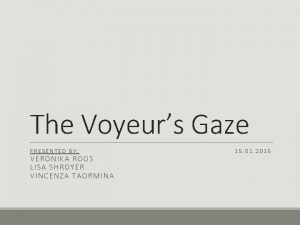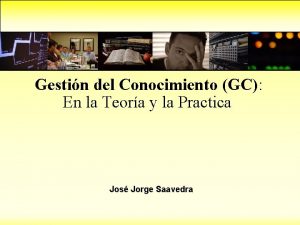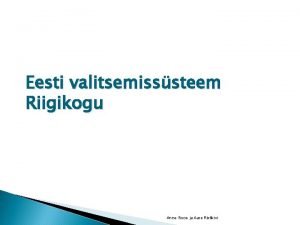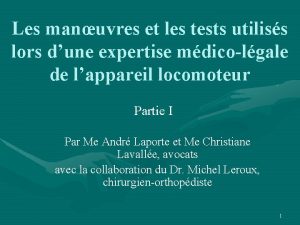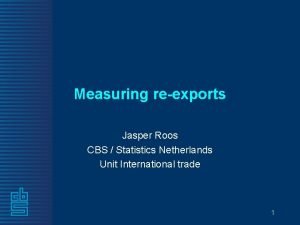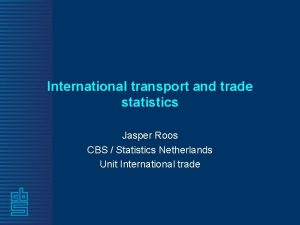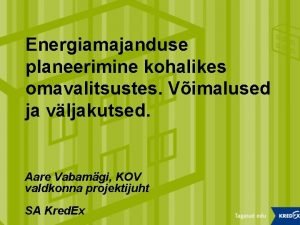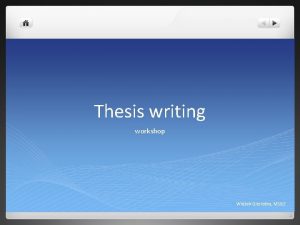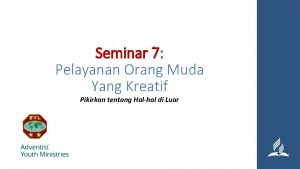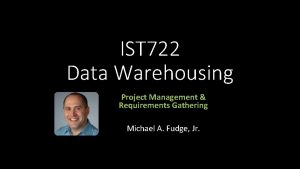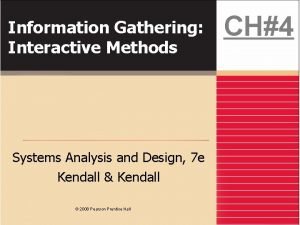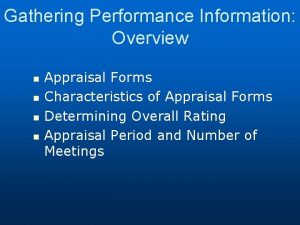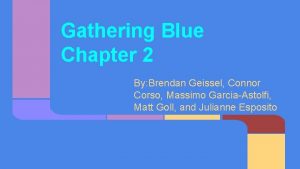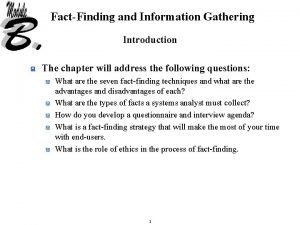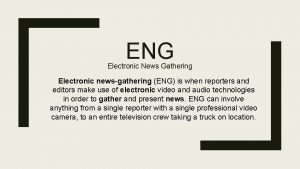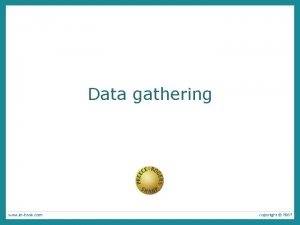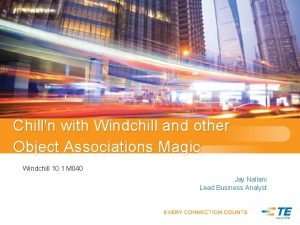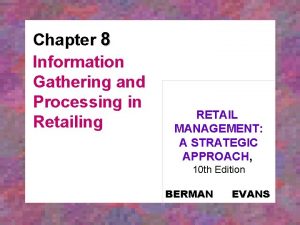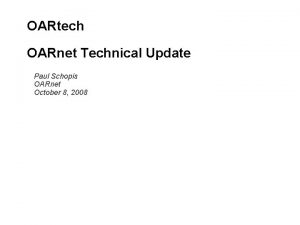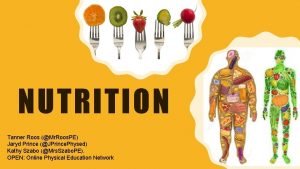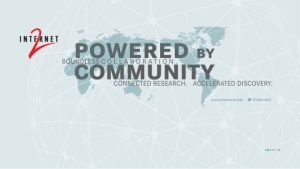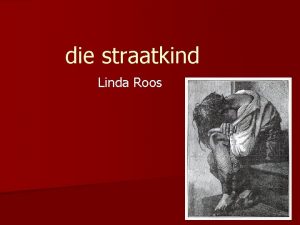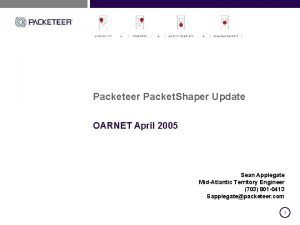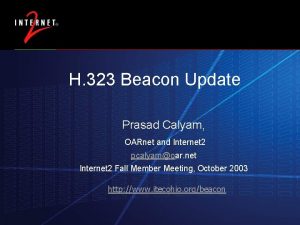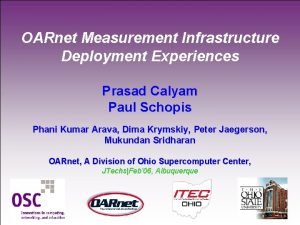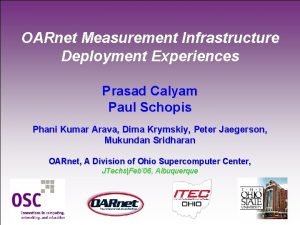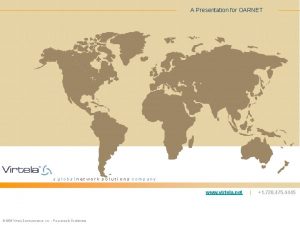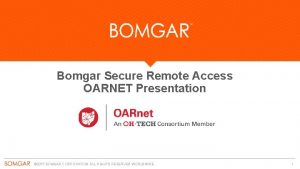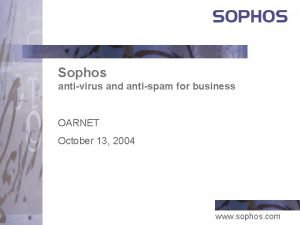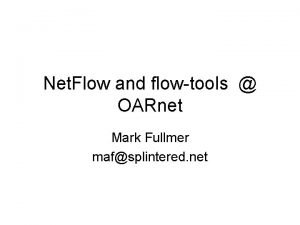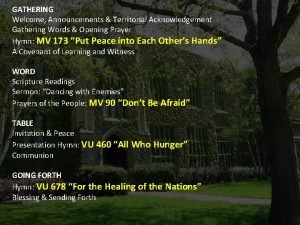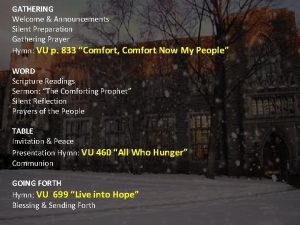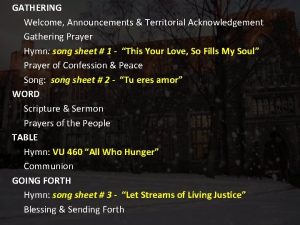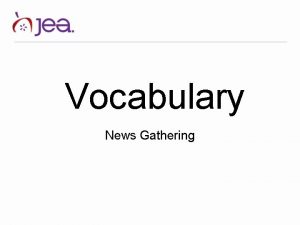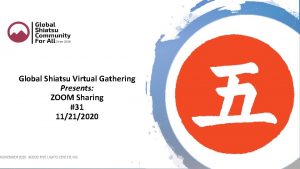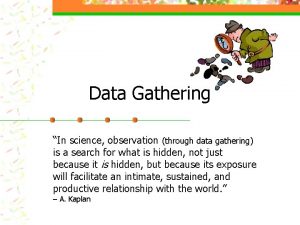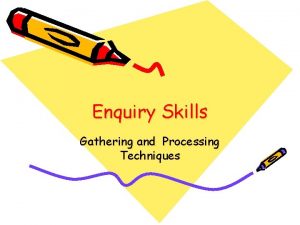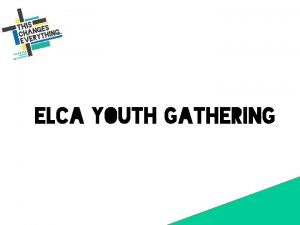OARnet Update Linda Roos Gathering of State Networks


























- Slides: 26

OARnet Update Linda Roos Gathering of State Networks February 4, 2004

Today’s Presentation • OARnet background • OARnet current network • Third Frontier Network

OARnet Background • Founded 1987 as part of the Ohio Supercomputing Center • 90+ higher ed member institutions • Board of Regents funding • OSTEER advisory council • Internet 2 gigapop

OARnet Background • Over 2 million users downstream • 1. 8 Gigabits of commodity internet • Ohio Valley Gigapop (Internet 2) 2. 5 Gbps • Maintain over 4000 interfaces • IP over ATM


Third Frontier Network • • Project Rationale History Backbone Acquisition and Funding Project Implementation

Project Rationale • Started with a Bold Vision – The Ohio Plan: a $900 million research and commercialization effort • Now Ohio’s $1. 6 B Third Frontier Project – A Dark fiber network was essential to the plan • Ohio has a diverse and distributed array of research universities – The state needs to use all its resources effectively • Universities need to be connected to business & industry • Goal: “researcher in Athens and colleague in Cleveland could work together as if labs next door to each others”

Rationale, continued • Network Plan was Built on a Strong History – Ohio Supercomputer Center and the Ohio Academic Resources Network (OARnet) were created in the mid-1980 s – School. Net created in the mid-1990 s

Rationale, continued • Why was Dark Fiber essential? – Cost and cost structure – Ability to manage the network to ensure: • Quality of Service • Smooth scalability

History • Given these circumstances, Ohio started to look at how to create a dark fiber network. • In 2001, OARnet made a tentative commitment to a start-up, Mission Networks, that proposed to deploy a new fiber network to Tier 2 and 3 cities in Ohio. • In early 2002, Mission Networks was unable to complete the financing for its project and did not build the network.

History • It created the idea of a project structure where – Phase 1 would be replacing OARnet’s backbone with dark fiber – Phase 2 would connect Ohio’s public universities, private research universities, and federal labs to the network with dark fiber – Phase 3 would be connecting other universities and colleges to the network. • Recommended moving forward with an RFP for Phase 1

New Network

Backbone Acquisition • In Summer of 2002, an RFP was issued • Dark fiber was strongly preferred, but vendors were invited to propose alternative leased services. • Vendors who bid dark fiber were required to offer a minimum of a single pair of fiber over their network.

Backbone Acquisition, cont. • Statewide dark fiber committee decided – leased lambdas were too expensive and not widely available. • Selected a bid from Spectrum Networks that offered a package of fiber from – American Electric Power – Williams Communications (Wiltel), and – American Fiber Systems (AFS)

Backbone Acquisition, cont. • Bid offered – Single pair of fibers – Connecting all of cities where OARnet had a POP. – City rings in Cleveland Columbus • A public ring was already in place in Cincinnati – Rings offering redundant routes to major cities.

Backbone Acquisition, cont. • Fiber Purchased – More than 1600 route miles – $4. 6 M for 20 year IRUs (Indefeasible Right of Use) – $342 K/yr for maintenance – Multiple types of fiber • SMF-28, Teralight, and Truewave Classic • Aerial and buried

Backbone Financing • Financing from Ohio State University – Long-term financing to pay for fiber ($7 M) • To be repaid by what OARnet had spent on its previous backbone – Short-term financing ($2 M) • To cover cost of running both networks in parallel and other start-up costs. • Financing from state capital budget – ($8. 5 M) • To pay for equipment and last-mile connections for public universities, private research universities, and federal labs (17 institutions).

Project Implementation • Guiding the project development – Multi-agency policy committee • School. Net, DAS, OBR, OSC, and OARnet – OARnet Advisory Committees • Lighting and Architecture; Price Modeling Committee; Last Mile Committee; Implementation Committee – OARnet Internal Staff Responsibilities • Project Management • Site Preparation • Network Management

Implementation, cont. • First Two Tasks: Integration and Conversion 1. Integration of purchased fibers • Additional IRUs and Right of Ways are required • Fiber cannot be characterized until fibers are connected • Equipment can not be specified until fibers are characterized. 2. Preparation for Conversion by connecting new POPs to old POPs. • Reduces the time required for conversion from old network to new network • Decreases the time needed to run both networks concurrently.

Implementation, cont. • Lessons learned – With multiple types of fiber, fibers will have different core sizes and splices will create inevitable core mismatches increasing attenuation. • You want to minimize the number of these splices if you want to support high-speed bandwidth. – Integration can be as or more legally complex process than purchasing the backbone fiber. • There are many more fiber purchase, right-ofway, and maintenance agreements required.

Equipment • Architectural choices – DWDM at the transport layer • So we can have multiple private networks each with its own lambda • Ability to provide Lambda for individual research project – MPLS rather than SONET • Does not use as much bandwidth for overhead • Provides equivalent fail-over times.

Equipment • Equipment Selection – Cisco selected for both Optical and Switching Gear • Cisco 15454 DWDM • GSR 12000 Routers – Equipment bought through SBC • SBC will do fiber characterization, configure, pretest, and install equipment. • OARnet Team responsible for site preparation

Equipment • Status – Equipment staged and tested at SBC facility – Installation commencing following site surveys and fiber characterization – Equipment being installed currently

Other Events • RFP has been issued for last-mile connectivity to all higher education and K-12 telecom aggregation sites; vendors responded, proposals being reviewed. • Setting policies on connecting to the network – Including business use of the network.

Next Steps • Light and test backbone in April/May/June • Connect first 17 institutions in June/July

Contact Information Linda Roos OARnet lroos@oar. net
 Immediate update and deferred update in dbms
Immediate update and deferred update in dbms Veronika roos
Veronika roos Modelo de von krogh y roos
Modelo de von krogh y roos Anne roos
Anne roos Debbie roos pollinator garden
Debbie roos pollinator garden Manoeuvre de cozen
Manoeuvre de cozen Jasper de roos
Jasper de roos Jasper roos
Jasper roos Aare vabamägi
Aare vabamägi A switch in a datagram network uses
A switch in a datagram network uses Basestore iptv
Basestore iptv Ux requirements gathering
Ux requirements gathering Instruments in quantitative research
Instruments in quantitative research Data gathering procedures example
Data gathering procedures example Tema seminar yang menarik untuk anak muda
Tema seminar yang menarik untuk anak muda Apa itu data requirement gathering
Apa itu data requirement gathering What is news gathering
What is news gathering Data warehouse requirements gathering
Data warehouse requirements gathering Information gathering: interactive methods
Information gathering: interactive methods Who should provide performance information
Who should provide performance information Gathering blue lesson plans
Gathering blue lesson plans Explain fact finding techniques
Explain fact finding techniques Electronic news gathering (eng)
Electronic news gathering (eng) Data gathering procedure
Data gathering procedure Five key issues of data gathering
Five key issues of data gathering Pro e windchill
Pro e windchill Information gathering and processing in retailing
Information gathering and processing in retailing

